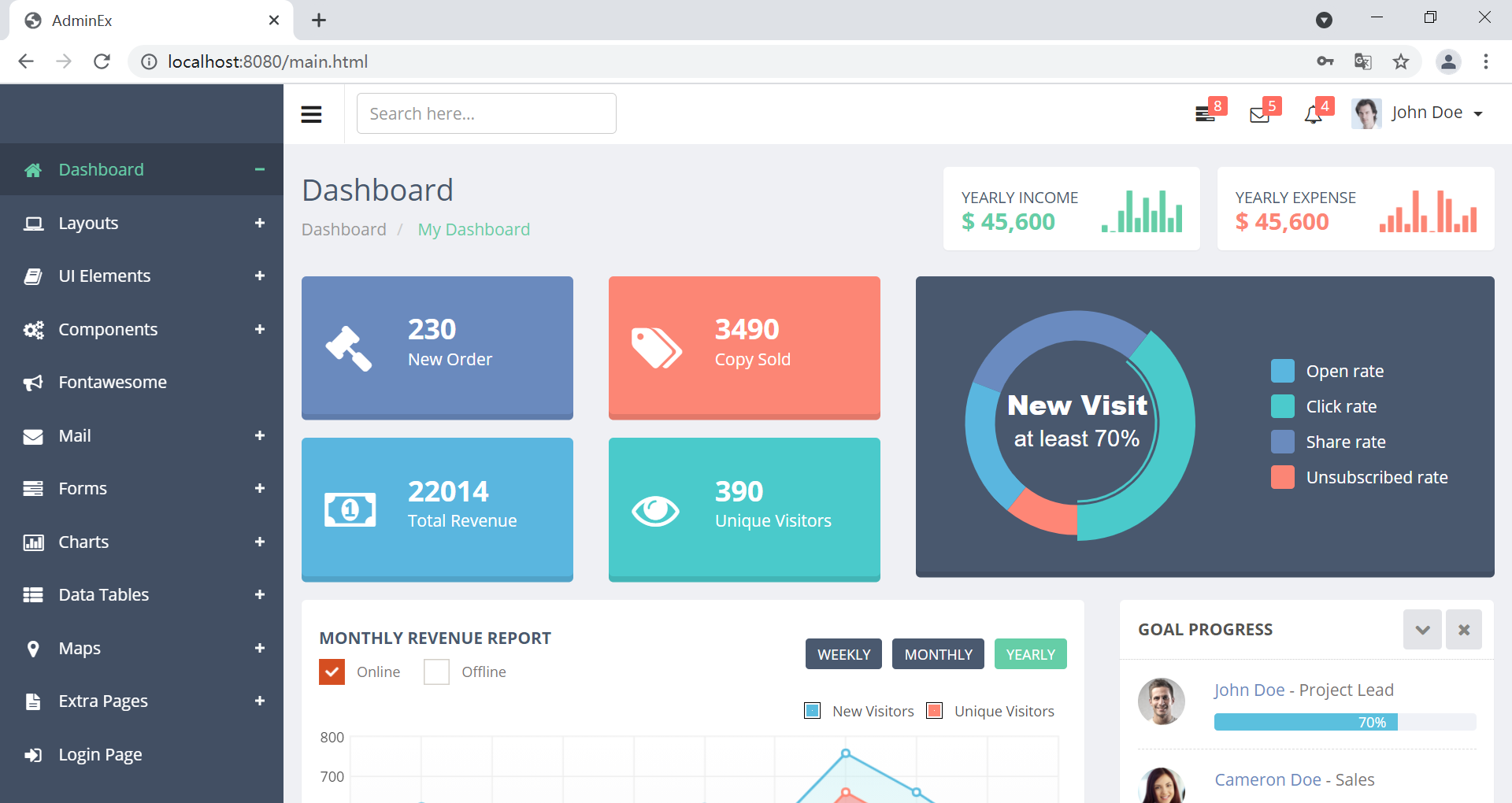Spring Boot 越来越流行,它主要就是简化 Spring 应用的搭建和开发过程,Spring 能做的事,Spring Boot 都可以做,因此得到越来越的企业的使用,那springboot怎么整合mybatis?下面来我们就来给大家讲解一下。
引入依赖
Spring Boot 整合 MyBatis 的第一步,就是在项目的 pom.xml 中引入 mybatis-spring-boot-starter 的依赖,示例代码如下。
<!--引入 mybatis-spring-boot-starter 的依赖--> <dependency> <groupId>org.mybatis.spring.boot</groupId> <artifactId>mybatis-spring-boot-starter</artifactId> <version>2.2.0</version> </dependency>
配置 MyBatis
在 Spring Boot 的配置文件(application.properties/yml)中对 MyBatis 进行配置,例如指定 mapper.xml 的位置、实体类的位置、是否开启驼峰命名法等等,示例代码如下。
###################################### MyBatis 配置###################################### mybatis: #指定 mapper.xml 的位置 mapper - locations: classpath: mybatis / mapper /*.xml #扫描实体类的位置,在此处指明扫描实体类的包,在 mapper.xml 中就可以不写实体类的全路径名 type-aliases-package: net.biancheng.www.bean configuration: #默认开启驼峰命名法,可以不用设置该属性 map-underscore-to-camel-case: true
注意:使用 MyBatis 时,必须配置数据源信息,例如数据库 URL、数据库用户型、数据库密码和数据库驱动等。
创建实体类
在指定的数据库内创建一个 user 表,并插入一些数据,如下表。

iduser_iduser_namepasswordemail
1001adminadmin1234567@qq.com
2002user123456987654@qq.com
3003bianchengbangqwertyuiopbianchengbang@sina.com
根据数据库 user 表,创建相应的实体类 User,代码如下。
package net.biancheng.www.bean;
public class User
{
private Integer id;
private String userId;
private String userName;
private String password;
private String email;
public Integer getId()
{
return id;
}
public void setId(Integer id)
{
this.id = id;
}
public String getUserId()
{
return userId;
}
public void setUserId(String userId)
{
this.userId = userId == null ? null : userId.trim();
}
public String getUserName()
{
return userName;
}
public void setUserName(String userName)
{
this.userName = userName == null ? null : userName.trim();
}
public String getPassword()
{
return password;
}
public void setPassword(String password)
{
this.password = password == null ? null : password.trim();
}
public String getEmail()
{
return email;
}
public void setEmail(String email)
{
this.email = email == null ? null : email.trim();
}
}创建 Mapper 接口
在 net.biancheng.www.mapper 中创建一个 UserMapper 接口,并在该类上使用 @Mapper 注解,代码如下。
package net.biancheng.www.mapper;
import net.biancheng.www.bean.User;
import org.apache.ibatis.annotations.Mapper;
@Mapper
public interface UserMapper
{
//通过用户名密码查询用户数据
User getByUserNameAndPassword(User user);
}当 mapper 接口较多时,我们可以在 Spring Boot 主启动类上使用 @MapperScan 注解扫描指定包下的 mapper 接口,而不再需要在每个 mapper 接口上都标注 @Mapper 注解。
创建 Mapper 映射文件
在配置文件 application.properties/yml 通过 mybatis.mapper-locations 指定的位置中创建 UserMapper.xml,代码如下。
<?xml version="1.0" encoding="UTF-8"?>
<!DOCTYPE mapper PUBLIC "-//mybatis.org//DTD Mapper 3.0//EN" "http://mybatis.org/dtd/mybatis-3-mapper.dtd">
<mapper namespace="net.biancheng.www.mapper.UserMapper">
<resultMap id="BaseResultMap" type="User">
<id column="id" jdbcType="INTEGER" property="id"/>
<result column="user_id" jdbcType="VARCHAR" property="userId"/>
<result column="user_name" jdbcType="VARCHAR" property="userName"/>
<result column="password" jdbcType="VARCHAR" property="password"/>
<result column="email" jdbcType="VARCHAR" property="email"/>
</resultMap>
<sql id="Base_Column_List">
id, user_id, user_name, password, email
</sql>
<!--根据用户名密码查询用户信息-->
<!--application.yml 中通过 type-aliases-package 指定了实体类的为了,因此-->
<select id="getByUserNameAndPassword" resultType="User">
select *
from user
where user_name = #{userName,jdbcType=VARCHAR}
and password = #{password,jdbcType=VARCHAR}
</select>
</mapper>使用 Mapper 进行开发时,需要遵循以下规则:
mapper 映射文件中 namespace 必须与对应的 mapper 接口的完全限定名一致。
mapper 映射文件中 statement 的 id 必须与 mapper 接口中的方法的方法名一致
mapper 映射文件中 statement 的 parameterType 指定的类型必须与 mapper 接口中方法的参数类型一致。
mapper 映射文件中 statement 的 resultType 指定的类型必须与 mapper 接口中方法的返回值类型一致。
示例 1
1. 在 spring-boot-adminex 项目中 net.biancheng.www.service 包中创建一个名为 UserService 的接口,代码如下。
package net.biancheng.www.service;
import net.biancheng.www.bean.User;
public interface UserService
{
public User getByUserNameAndPassword(User user);
}2. 在 net.biancheng.www.service.impl 包中创建 UserService 接口的实现类,并使用 @@Service 注解将其以组件的形式添加到容器中,代码如下。
package net.biancheng.www.service.impl;
import net.biancheng.www.bean.User;
import net.biancheng.www.mapper.UserMapper;
import net.biancheng.www.service.UserService;
import org.springframework.beans.factory.annotation.Autowired;
import org.springframework.stereotype.Service;
@Service("userService")
public class UserServiceImpl implements UserService
{
@Autowired
UserMapper userMapper;
@Override
public User getByUserNameAndPassword(User user)
{
User loginUser = userMapper.getByUserNameAndPassword(user);
return loginUser;
}
}3. 修改 LoginController 中的 doLogin() 方法 ,代码如下。
package net.biancheng.www.controller;
import lombok.extern.slf4j.Slf4j;
import net.biancheng.www.bean.User;
import net.biancheng.www.service.UserService;
import org.springframework.beans.factory.annotation.Autowired;
import org.springframework.stereotype.Controller;
import org.springframework.web.bind.annotation.RequestMapping;
import javax.servlet.http.HttpSession;
import java.util.Map;
@Slf4j
@Controller
public class LoginController
{
@Autowired
UserService userService;
@RequestMapping("/user/login")
public String doLogin(User user, Map < String, Object > map, HttpSession session)
{
//从数据库中查询用户信息
User loginUser = userService.getByUserNameAndPassword(user);
if (loginUser != null)
{
session.setAttribute("loginUser", loginUser);
log.info("登陆成功,用户名:" + loginUser.getUserName());
//防止重复提交使用重定向
return "redirect:/main.html";
}
else
{
map.put("msg", "用户名或密码错误");
log.error("登陆失败");
return "login";
}
}
}4. 启动 Spring Boot,浏览器地址栏输入“http://localhost:8080/” ,访问 AdminEx 系统的登陆页面,分别输入用户名“user”和密码“123456”,结果下图。

5. 点击登陆按钮,结果如下图。

注解方式
通过上面的学习,我们知道 mapper 映射文件其实就是一个 XML 配置文件,它存在 XML 配置文件的通病,即编写繁琐,容易出错。即使是一个十分简单项目,涉及的 SQL 语句也都十分简单,我们仍然需要花费一定的时间在mapper 映射文件的配置上。
为了解决这个问题,MyBatis 针对实际实际业务中使用最多的“增伤改查”操作,分别提供了以下注解来替换 mapper 映射文件,简化配置:
@Select
@Insert
@Update
@Delete
通过以上注解,基本可以满足我们对数据库的增删改查操作,示例代码如下。
package net.biancheng.www.mapper;
import net.biancheng.www.bean.User;
import org.apache.ibatis.annotations.*;
import java.util.List;
@Mapper
public interface UserMapper
{
@Select("select * from user where user_name = #{userName,jdbcType=VARCHAR} and password = #{password,jdbcType=VARCHAR}")
List < User > getByUserNameAndPassword(User user);
@Delete("delete from user where id = #{id,jdbcType=INTEGER}")
int deleteByPrimaryKey(Integer id);
@Insert("insert into user ( user_id, user_name, password, email)" +
"values ( #{userId,jdbcType=VARCHAR}, #{userName,jdbcType=VARCHAR}, #{password,jdbcType=VARCHAR}, #{email,jdbcType=VARCHAR})")
int insert(User record);
@Update(" update user" +
" set user_id = #{userId,jdbcType=VARCHAR},\n" +
" user_name = #{userName,jdbcType=VARCHAR},\n" +
" password = #{password,jdbcType=VARCHAR},\n" +
" email = #{email,jdbcType=VARCHAR}\n" +
" where id = #{id,jdbcType=INTEGER}")
int updateByPrimaryKey(User record);
}这样就完成了springboot整合mybatis的相关步骤,将其进行整合,能够更加方便程序员开发,使其使用更加灵活,所以我们要会springboot整合mybatis哦!最后大家如果想要了解更多java架构师知识,敬请关注奇Q工具网。
推荐阅读:
